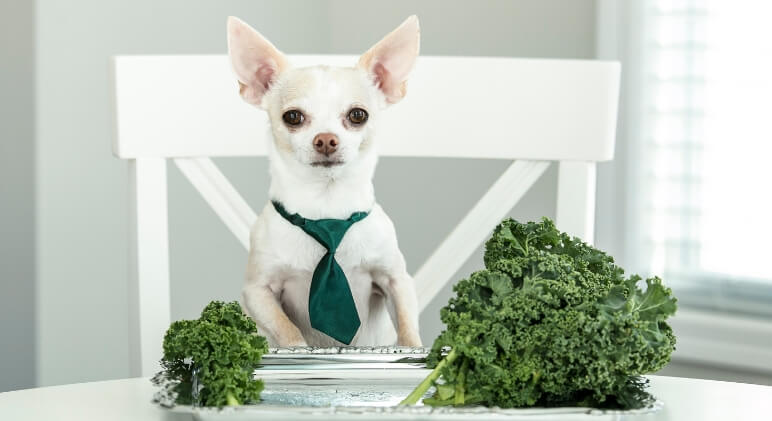
Can Dogs Eat Kale? Yes, dogs can enjoy kale in small, occasional portions. This leafy green is rich in nutrients like vitamins A, C, and K, which support overall health and can be a tasty addition to your dog’s diet when served in moderation.
However, kale isn’t suitable for every dog. Pups with kidney issues or food sensitivities should avoid it due to its high oxalate content. Let’s explore the benefits, risks, and tips for safely sharing kale with your furry friend! Let’s break it down! Let’s explore that- Can Dogs Eat Kale?
Nutritional Facts About Kale for Dogs
Kale is a powerhouse of nutrients that can offer several health benefits for dogs when fed in moderation. Here’s a breakdown of some key nutritional facts about kale and how they can support your dog’s health:
1. Vitamins A, C, and K
- Vitamin A supports healthy vision, immune function, and cell growth.
- Vitamin C acts as a powerful antioxidant, helping to strengthen the immune system and fight off infections.
- Vitamin K plays a crucial role in blood clotting and maintaining healthy bones.
2. Minerals
- Calcium is essential for strong bones and teeth, promoting overall skeletal health.
- Magnesium works together with calcium to support muscle function and regulate the nervous system.
- Potassium helps maintain proper fluid balance and supports heart and muscle health.
3. Antioxidants
- Kale is rich in antioxidants, which help to reduce inflammation and fight off free radical damage in the body.
- These antioxidants can contribute to overall well-being and may be especially beneficial for older dogs or those with inflammatory conditions.
4. Low Calories
- With its low calorie content, kale makes a great healthy snack for dogs, especially those on a weight-management diet.
- It’s a satisfying, nutrient-dense option that doesn’t contribute significantly to weight gain.
When included in small amounts, kale can be a beneficial addition to your dog’s diet, providing essential vitamins, minerals, antioxidants, and fiber. It’s important to remember that kale should be fed as an occasional treat and prepared properly to avoid potential risks. Always check with your vet before introducing new foods into your dog’s routine to ensure it’s a good fit for their specific needs.
Health Benefits of Kale for Dogs
Kale can offer several health benefits for dogs when included in their diet in moderation. Here’s how this leafy green can help improve your dog’s well-being:
1. Digestive Health
- Kale’s high fiber content helps to support healthy digestion and promotes regular bowel movements.
- It can help prevent constipation by adding bulk to your dog’s stool and aiding in smoother digestion.
2. Immune Support
- The combination of vitamins A, C, and antioxidants found in kale helps strengthen your dog’s immune system.
- These nutrients help protect against infections and support your dog’s overall health by fighting off harmful free radicals.
3. Skin and Coat Health
- Vitamin A, abundant in kale, plays a significant role in maintaining healthy skin and promoting a shiny, soft coat.
- A shiny coat and healthy skin are indicators of good nutrition, and kale can help improve both when added to your dog’s diet.
4. Bone Health
- Kale is rich in calcium and vitamin K, both of which contribute to strong, healthy bones.
- These nutrients are important for bone density, especially in growing puppies, aging dogs, or breeds prone to bone issues.
When given in moderation and properly prepared, kale can support your dog’s digestive health, immune system, skin and coat, and even bone strength. Always ensure to serve kale as an occasional treat rather than a main meal, and consult with your vet if you have any concerns about its inclusion in your dog’s diet.
Risks of Feeding Kale to Dogs
While kale can provide some health benefits, it’s important to be aware of the potential risks when feeding it to your dog. Here’s what you need to know:
1. Oxalates: Kidney and Bladder Stones Risk
- Kale contains oxalates, compounds that can bind with calcium and form crystals. In large quantities, oxalates may contribute to the development of kidney or bladder stones in susceptible dogs.
- Dogs with a history of urinary issues or kidney problems should avoid kale or consume it sparingly.
2. Isothiocyanates: Digestive Upset
- Kale contains isothiocyanates, compounds that may cause digestive upset in some dogs. When fed in large amounts, these compounds can lead to gas, bloating, or stomach discomfort.
- To prevent digestive issues, it’s best to offer kale in small portions and monitor your dog’s reaction.
3. Raw Kale: Choking Hazard and Tough Texture
- Raw kale has a tough, fibrous texture, which can be hard for some dogs to chew and digest.
- If not properly prepared, raw kale could become a choking hazard or lead to digestive discomfort.
- Always cook or steam kale to make it easier to chew and digest for your dog.
While kale can be a healthy treat in moderation, you should be cautious of its risks. Oxalates can cause kidney problems, and isothiocyanates can upset digestion. Additionally, raw kale’s tough texture may cause difficulties for your dog. Always prepare kale properly and consult your vet if you have concerns about including it in your dog’s diet.
Feeding Tips for Kale
If you decide to feed your dog kale, it’s important to do so safely to avoid any potential digestive issues or health concerns. Here are some helpful tips to ensure you’re feeding kale in the best way:
1. Cook It First
- Steaming or boiling kale helps reduce harmful compounds, like oxalates, that could pose a risk to your dog’s health. Cooking makes kale safer by breaking down these compounds, making it easier for your dog to digest.
- Avoid adding seasoning, butter, or oils when cooking, as these may not be suitable for dogs.
2. Remove Tough Stems
- Kale stems can be tough and difficult for your dog to chew, potentially leading to choking hazards or digestive issues.
- Always remove the tough stems and chop the kale leaves into small, manageable pieces to make it easier for your dog to chew and digest.
3. Portion Control
- Serve kale in small portions. Large amounts of kale may overwhelm your dog’s digestive system, especially since it’s high in fiber.
- Treat kale as an occasional snack rather than a regular part of their diet to prevent any digestive discomfort like gas or diarrhea.
4. Combine with Other Dog-Safe Foods
- Kale can be mixed with other dog-friendly foods to add variety to your dog’s diet. Consider combining kale with other safe vegetables like carrots or green beans to provide a balanced and enjoyable treat.
- Mixing kale with other ingredients can also help mask the bitter taste if your dog is picky.
Feeding your dog kale can be a healthy addition to their diet if done properly. Always cook it, remove tough stems, control portion sizes, and consider combining it with other dog-safe foods. By following these tips, you can safely offer kale as an occasional treat without causing digestive issues.
Dog-Friendly Alternatives to Kale
While kale can be a healthy treat for dogs when fed properly, there are other dog-friendly alternatives that also offer great nutritional benefits. Here are some excellent substitutes to consider:
1. Spinach
- Nutrient-Rich: Like kale, spinach is full of vitamins A, C, and K, along with iron and antioxidants.
- Feed Sparingly: Though spinach is safe for dogs, it contains oxalates, so it’s best to feed it in moderation to avoid any potential kidney or bladder stone risks.
2. Green Beans
- Crunchy & Low-Calorie: Green beans are a great choice for dogs looking for a crunchy, low-calorie treat.
- Easy to Digest: They’re simple for dogs to chew and easy on the stomach, making them an excellent snack option for all dog breeds.
3. Carrots
- Rich in Beta-Carotene: Carrots are packed with vitamins A and beta-carotene, which are beneficial for your dog’s vision and immune system.
- Digestible & Healthy: These crunchy vegetables are easy to digest and can help support dental health as well.
4. Zucchini
- Gentle on the Stomach: Zucchini is a mild vegetable that is very gentle on your dog’s digestive system.
- Hydrating: Since zucchini has a high water content, it also helps keep your dog hydrated, making it an ideal snack during warm weather.
If you’re looking for alternatives to kale, consider these dog-friendly options like spinach, green beans, carrots, and zucchini. Each of these vegetables is nutritious and offers various health benefits. Just remember to feed them in moderation and ensure they are prepared properly for your dog’s safety and enjoyment!



